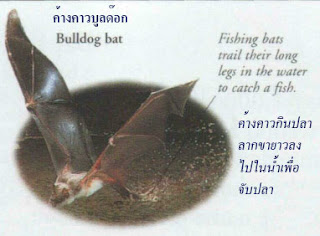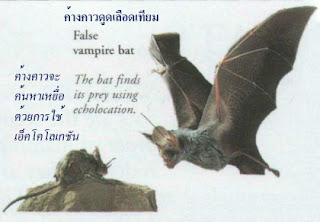Feeding
Bats have a wide
variety of food sources. Most bats eat
insects and can consume huge amounts in one night. The smaller bats, such as pipistrelles, catch tiny
gnats and mosquitoes. Larger bats, such as
noctules and serotines, feed on cockchafers and dung
beetles. Some bats pounce on prey that is on the ground, and pick insects off leaves. Fruit-eating bats live mostly in the tropics,
where they have a year-round supply
of food.
|
การกินอาหาร
ค้างคาวมีแหล่งอาหารหลากหลายกว้างขวาง
ค้างคาวส่วนใหญ่จะกินแมลงและบริโภคอาหารจำนวนมากในเวลาคืนเดียว ค้างคาวตัวเล็ก ๆ
เช่น ค้างคาว pipistrelle (ค้างคาวยุโรปสีน้ำตาลขนาดเล็ก) จะจับแมลงตัวเล็ก ๆ และยุงกินเป็นอาหาร
ค้างคาวขนาดใหญ่ เช่น ค้างคาวกินแมลงและค้างคาวท้องสีน้ำตาลใหญ่ จะกินแมงอีนูนและหนอนที่กินมูลสัตว์
ค้างคาวบางชนิดจะจู่โจมเข้าหาเหยื่อที่อยู่บนพื้นดิน และจิกแมลงจากใบไม้กิน ค้างคาวกินแมลงส่วนใหญ่จะอาศัยอยู่ในภูมิภาคเขตร้อนซึ่งจะมีอาหารตลอดทั้งปี
|
|||
Fishing bats
Some bats use echolocation
to detect fish just below the water's surface. Fishing bats have long legs and they
fly along the surface and catch the fish with long,
sharp claws.
|
ค้างคาว Fishing Bat
ค้างคาวบางชนิดจะใช้เอ็คโคโลเกชันเพื่อหาปลาที่อยู่ใต้พื้นน้ำ
ค้างคาว Fishing
Bat จะมีขายาวและพวกมันจะบินไปตามผิวน้ำพร้อมทั้งจับปลาด้วยกรงเล็บที่ยาวแหลมคม
|
Meat-eating
bats
Many larger microbats
catch and eat mice, rats, frogs, and lizards. False vampire bats from Asia and America carry
their catch to a suitable perch to devour it, using their thumbs and wing membranes to hold the heavy prey.
|
ค้างคาวกินเนื้อ
ค้างคาวกินแมลงขนาดใหญ่จะจับและกินหนูเล็กใหญ่กบและกิ้งก่าเป็นอาหาร
ค้างคาวดูดเลือดเทียมจากเอเชียและอเมริกาจะจับแมลงเหล่านั้นหาที่เกาะที่เหมาะสมแล้วกินเหยื่ออย่างตะกละตะกลาม
โดยใช้อุ้งเล็บและเยื่อแผ่นหุ้มปีกจังเหยื่อขนาดใหญ่
|
|
Vampire bat
True vampire bats
feed on the blood of mammals or birds. Using their razorlike incisor teeth,
they make a wound on an ear or
ankle. As the blood flows, the vampire bat drinks it with a grooved
tongue that acts like a drinking straw.
|
ค้างค้าวดูดเลือด
ค้างคาวดูดเหลือดแท้จะกินเลือดของสัตว์เลี้ยงลูกด้วยนมหรือนกเป็นอาหาร
พวกมันจะสร้างแผลที่ใบหูหรือข้อเท้าด้วยการใช้ฟันหน้าที่คล้ายกับใบมีดโกน ในขณะที่เลือดไหลออกมา
ค้างคาวดูดเลือดจะดื่มเลือดด้วยลิ้นที่เป็นร่องที่ทำหน้าที่คล้ายกับหลอดดูดของเหลว
|
Nursery
Like all true
mammals, a female bat carries her young inside her womb
until she gives birth. Usually, only one bat is born at
a time to minimize the extra weight
a pregnant female has to carry in flight. Females
gather, often in large numbers, to
give birth in a nursery roost.
|
สถานที่เลี้ยงดูลูก
ค้างคาวตัวเมียคล้ายกับสัตว์เลี้ยงลูกด้วยนมแท้ทุกชนิด
จะอุ้มท้องจนกระทั่งให้กำเนิด ปกติแล้วค้างคาวตัวหนึ่งจะให้กำเนิดลูกเพียงตัวเดียวเท่านั้นในครั้งหนึ่งเพื่อลดน้ำหนักเกินที่ค้างคาวตัวเมียที่กำลังตั้งท้องจะต้องบิน
ปกติแล้วค้างคาวจะมาอยู่รวมกันเป็นจำนวนมากเพื่อให้กำเนิดลูกในสถานที่ให้กำเนิดลูก
|
|||
Threats and predators
This red-tailed racer from Southeast Asia, also
known as a mangrove ratsnake, catches bats in the tops of mangrove trees. Other animals that prey on bats include bat hawks, owls, and
cats. Some of the greatest threats
to the survival of bats around the world are habitat destruction, pesticides, and human
vandalism. Many species are in
danger of extinction.
|
ภัยคุกคามและนักล่า
งูผอมบางเคลื่อนไหวเร็วมีหางสีแดงชนิดนี้จากเอเชียตะวันออกเฉียงใต้หรือที่รู้จักกันในชื่อ
งูสิงธรรมดา ที่อยู่ตามป่าชายเลนจะจับค้างคาวที่อยู่บนยอดของต้นโกงกางกินเป็นอาหาร
สัตว์อื่น ๆ ที่กินค้างคาวเป็นเหยื่อ ได้แก่ เหยี่ยวค้างคาว นกฮูกและแมว
ภัยคุกคามที่ยิ่งใหญ่ที่สุดบางส่วนในการอยู่รอดของค้างคาวทั่วโลกคือการทำลายที่อยู่อาศัย
สารกำจัดศัตรูพืชและพฤติกรรมการทำลายของมนุษย์ ค้างคาวหลายชนิดเสี่ยงต่อการสูญพันธุ์
|
Largest
and smallest
The
largest bat is a Malaysian flying fox which can have a wingspan of up to 1.7 m (5.6 ft). The smallest bat is
the bumblebee bat, also known as Kitti's hog-nosed bat. This tiny animal
is only about 30 mm (1 in) long and weighs only 2 g (0.07
oz).
|
ค้างคาวใหญ่ที่สุดและเล็กที่สุด
ค้างคาวที่ใหญ่ที่สุดคือค้างคาวแม่ไก่มาเลเซียซึ่งมีความกว้างของปีกระหว่างปลายปีกทั้งสองข้างวัดได้ถึง
1.7 เมตร (5.6 ฟุต) ค้างคาวที่เล็กที่สุดคือค้างคาวคุณกิตติหรือที่ฝรั่งเรียกว่า Kitti's
hog-nosed bat (ค้างคาวหน้าหมูคุณกิตต) สัตว์ขนาดเล็กนี้มีความยาวประมาณ
30 มม. (1 นิ้ว) และมีน้ำหนักเพียง 2
กรัม (0.07 ออนซ์)
|
|








